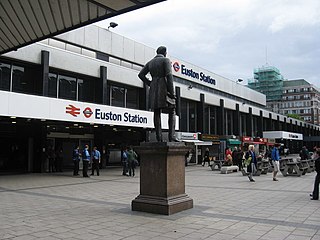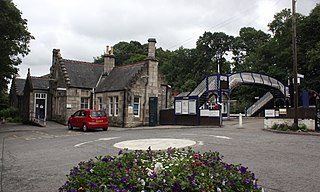
The West Coast Main Line (WCML) is one of the most important railway corridors in the United Kingdom, connecting the major cities of London and Glasgow with branches to Birmingham, Liverpool, Manchester and Edinburgh. It is one of the busiest mixed-traffic railway routes in Europe, carrying a mixture of intercity rail, regional rail, commuter rail and rail freight traffic. The core route of the WCML runs from London to Glasgow for 399 miles (642 km) and was opened from 1837 to 1869. With additional lines deviating to Northampton, Birmingham, Manchester, Liverpool and Edinburgh, this totals a route mileage of 700 miles (1,127 km). The Glasgow–Edinburgh via Carstairs line connects the WCML to Edinburgh, however the main London–Edinburgh route is the East Coast Main Line. Several sections of the WCML form part of the suburban railway systems in London, Coventry, Birmingham, Liverpool, Manchester and Glasgow, with many more smaller commuter stations, as well as providing links to more rural towns.

Euston railway station is a central London railway terminus in the London Borough of Camden, managed by Network Rail. It is the southern terminus of the West Coast Main Line, the UK's busiest inter-city railway. Euston is the fifth-busiest station in Britain and the country's busiest inter-city passenger terminal, being the gateway from London to the West Midlands, North West England, North Wales and Scotland. Intercity express passenger services are operated by Avanti West Coast and overnight services to Scotland are provided by the Caledonian Sleeper. West Midlands Trains and London Overground provide regional and commuter services.

Glasgow Central is one of two principal mainline rail terminals in Glasgow, Scotland. The station was opened by the Caledonian Railway on 1 August 1879 and is one of 20 managed by Network Rail. It is the northern terminus of the West Coast Main Line, and for inter-city services between Glasgow and England. The other main station in the centre of the city is Glasgow Queen Street.

Crewe railway station is a railway station in Crewe, Cheshire, England. It opened in 1837 and is one of the most historically significant railway stations in the world.

Lockerbie railway station lies on the West Coast Main Line between Carlisle and Carstairs in Lockerbie, Dumfries and Galloway, Scotland. It is located 75 miles south of Glasgow Central and 324 miles north of London Euston. The station is owned by Network Rail.

A train reporting number in Great Britain identifies a particular train service. It consists of:

Aviemore railway station serves the town and tourist resort of Aviemore in the Highlands of Scotland. The station, which is owned by Network Rail (NR) and managed by Abellio ScotRail, is on the Highland Main Line between Perth and Inverness, and is also the southern terminus of the Strathspey preserved railway.

The British Rail Class 90 electric locomotives were built for mixed-traffic duties, operating from 25 kV AC overhead lines and produce 5,000 bhp (3,700 kW). They weigh 84.5 tonnes and can typically achieve a top speed of 110 mph (177 km/h).

Carlisle railway station, or Carlisle Citadel, is a Grade II* listed railway station serving the city of Carlisle, Cumbria, England. It is on the West Coast Main Line, 102 miles (164 km) south east of Glasgow Central, and 299 miles (481 km) north north west of London Euston. It is the northern terminus of the Settle and Carlisle Line, a continuation of the Midland Main Line from Leeds, Sheffield and London St Pancras. It is so named because it is adjacent to Carlisle Citadel, a former medieval fortress. The station is owned by Network Rail.

Inverness railway station is the railway station serving the Scottish city of Inverness.

Wigan North Western railway station is one of two railway stations serving the town centre of Wigan, Greater Manchester, England.

The Royal Scot was a British named express passenger train that ran between London Euston and Glasgow Central, the length of the West Coast Main Line (WCML), with previously a portion also going to Edinburgh.

Caledonian Sleeper is the collective name for overnight sleeper train services between London and Scotland, in the United Kingdom. It is one of only two currently operating sleeper services on the railway in the United Kingdom, the other being the Night Riviera which runs between London and Penzance.

Dunblane railway station serves the town of Dunblane in central Scotland. It is located on the former Scottish Central Railway, between Stirling and Perth and opened with the line in 1848. It is the northernmost station on the National Rail network to be electrified.

Coatbridge Central railway station is a station in Coatbridge, North Lanarkshire, Scotland. It is on the Argyle Line. Train services are provided by Abellio ScotRail.

Carluke railway station is a railway station on the West Coast Main Line (WCML) that serves the town of Carluke, South Lanarkshire, Scotland. The station is managed by Abellio ScotRail and is predominantly served by Argyle Line commuter trains running between Lanark and Glasgow Central. The station lies at the western edge of the town, and enjoys panoramic views of the Clyde Valley and beyond to the hills of Lanarkshire and Ayrshire.

Pitlochry railway station, located on the Highland main line, serves the town of Pitlochry in Perth and Kinross, Scotland. It is served regularly by Abellio ScotRail trains between Glasgow or Edinburgh and Inverness, the daily Caledonian Sleeper service to and from London Euston and the daily London North Eastern Railway service between London King's Cross and Inverness via York along the East Coast Main Line.

Carstairs railway station serves the village of Carstairs in South Lanarkshire, Scotland and is a major junction station on the West Coast Main Line (WCML), situated close to the point at which the lines from London Euston and Edinburgh to Glasgow Central merge. Constructed originally by the Caledonian Railway, the station is operated today by Abellio ScotRail and is also served by one TransPennine Express trains service per day between Manchester Airport and Glasgow Central. All other services by TransPennine Express and services operated by Avanti West Coast, Caledonian Sleeper, CrossCountry and London North Eastern Railway pass the station, but do not stop.

The Caledonian was a British express passenger train of the 1950s and 1960s running between Glasgow Central and London Euston, up in the morning, due into London in mid-afternoon, and down in the afternoon, with a Glasgow arrival in the late evening. It was operated by the London Midland Region of British Railways and was non-stop between Carlisle and London.

On the evening of 26 December 1962, cold weather and snow in and around Crewe had caused points to become frozen and trains were being detained at signals. About midway between Winsford and Crewe, the 13:30 Glasgow Central to London Euston Mid-Day Scot, hauled by an English Electric type 4 diesel, with 13 coaches and 500 passengers, was stopped at a signal but the driver found the telephone to Coppenhall Junction, the next signal box ahead, out of order. Seeing the next signal ahead he decided to proceed down towards it and use the telephone there, but too fast. In the darkness he failed to notice the 16:45 express from Liverpool Lime Street to Birmingham New Street, hauled by an electric locomotive with eight coaches with 300 passengers, standing on the line ahead and collided with it at about 20 mph (32 km/h).




















